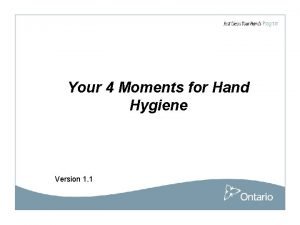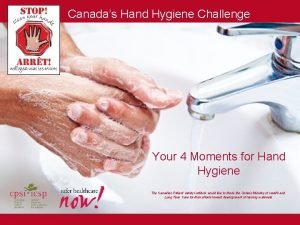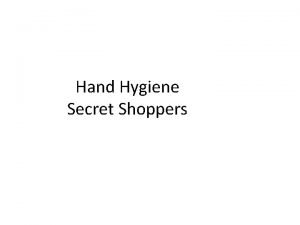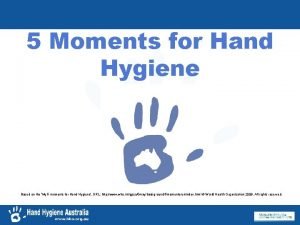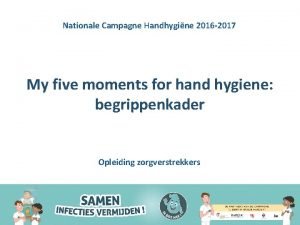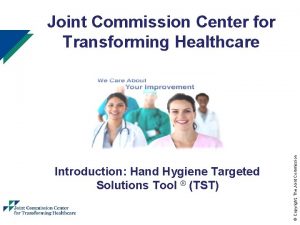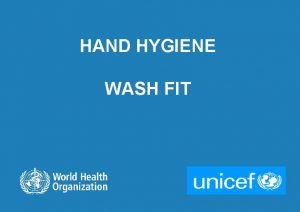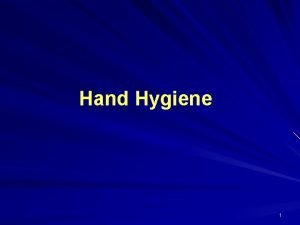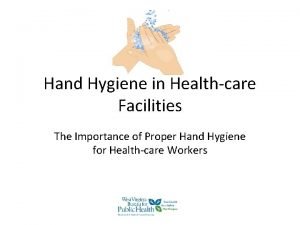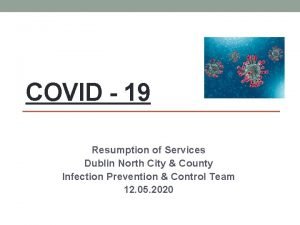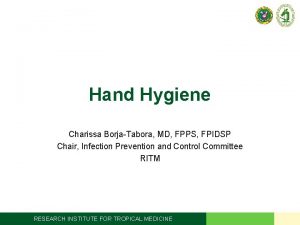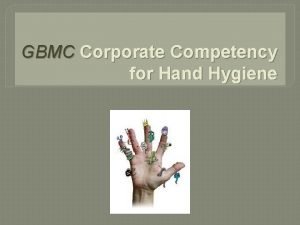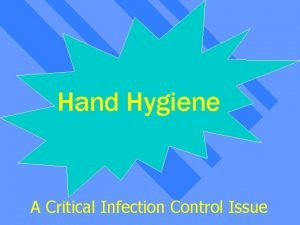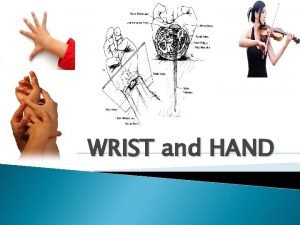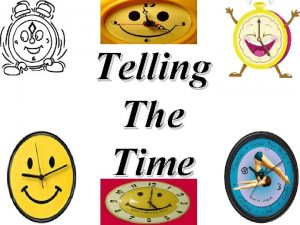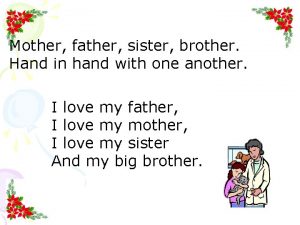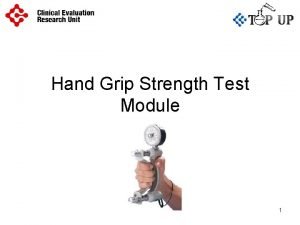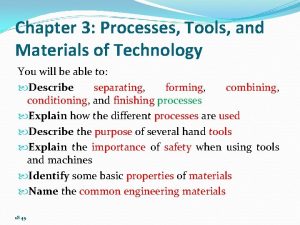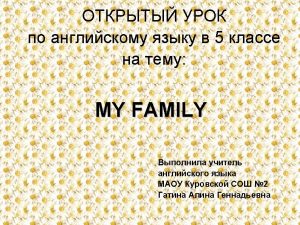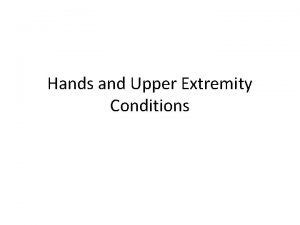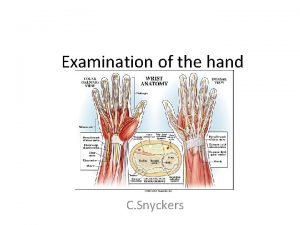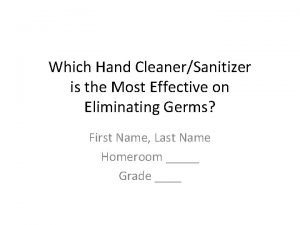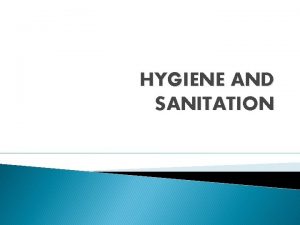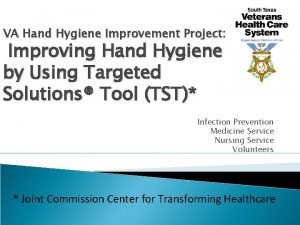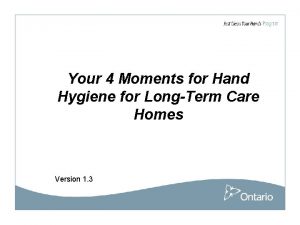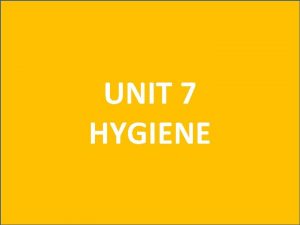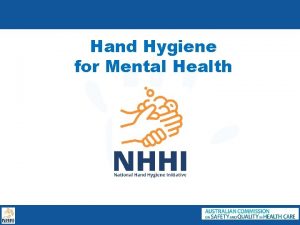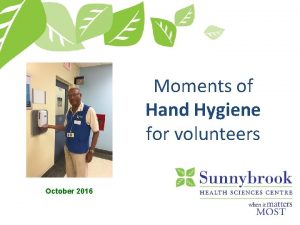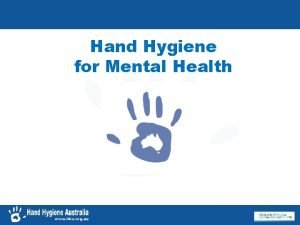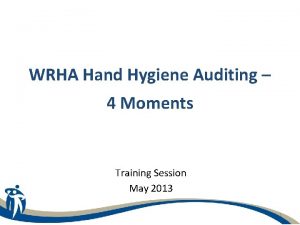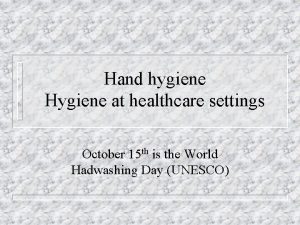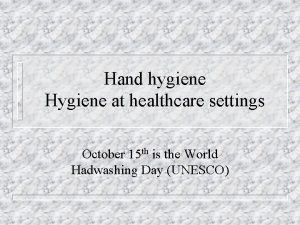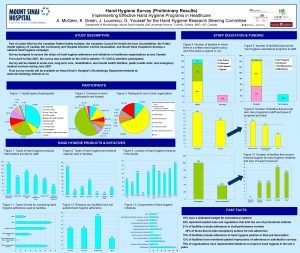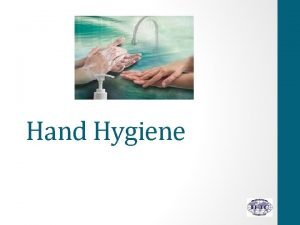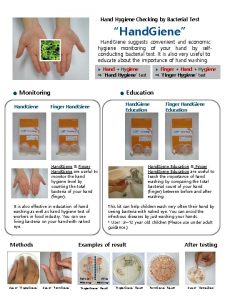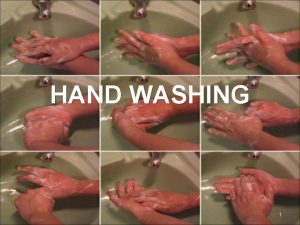Your 4 Moments for Hand Hygiene Version 1






























- Slides: 30

Your 4 Moments for Hand Hygiene Version 1. 1

Acknowledgement • The Ministry of Health and Long-Term Care would like thank the WHO World Alliance for Patient Safety for sharing its Clean Care is Safer Care materials. This presentation includes slides from annex 16 and concepts from the Observer’s Manual of Clean Care is Safer Care, the WHO multimodal hand hygiene improvement strategy developed by the World Alliance for Patient Safety. • Ontario congratulates WHO on the clearly articulated concept of “ 5 Moments” to perform hand hygiene. Ontario has done a local adaptation of the 5 Moments concept and will be teaching Your 4 Moments for Hand Hygiene. The 4 Moments includes six indications for hand hygiene. 2

Instructions for trainers • This presentation should be used by trainers to teach health care providers and observers the essential moments for hand hygiene using the 4 Moments for Hand Hygiene concept. Health care providers include all who work with patients or in the patient care unit. • Trainers are encouraged to add slides to provide local context by including local compliance rates and local data on health care associated infections. Trainers may also wish to include slides from “The Science Behind Just Clean Your Hands” presentation to supplement content. • During the session, the discussion and health care provider participation should be stimulated as much as possible in order to achieve an optimal understanding of the key messages. • The presentation can be given in a single session of approximately 45 minutes or split up into shorter sessions covering one of each of the 4 Moments for Hand Hygiene. • Public Health Ontario offers online learning in infection prevention and control. For hand hygiene, review the IPAC Core Competencies course, specifically the Health Care Provider Controls module. 3

Perfoming hand hygiene: “when and how” Overview: 1. Discussion of two environments for hand hygiene and the impact on transmission of organisms 2. Review of two methods for cleaning hands and the importance of technique in reducing the spread of infections and maintaining skin integrity 3. Practical training for health care providers on the essential moments for hand hygiene -Your 4 Moments for Hand Hygiene 4. A high-level overview of the observational audit process 4

Did you know? • Health care associated infections (HAI) are the most common serious complication of hospitalization: (one in nine patients admitted to Canadian hospitals acquire an infection as a consequence of their hospital stay. ) • In Canada, it has been estimated that 220, 000 incidents of HAI occur each year, resulting in more than 8, 000 deaths. (Zoutman et al 2003) • 8000 deaths/year is approximately the same as the number of deaths from breast cancer and motor vehicle accidents/year • Health care associated infections were the 11 th leading cause of death two decades ago, but are now the fourth leading cause of death for Canadians (behind cancer, heart disease and stroke). • An increase in hand hygiene adherence of only 20 per cent results in a 40 per cent reduction in the rate of health care associated infections. (Mc. Geer, A. “Hand Hygiene by Habit”. Infection prevention: practical tips for physicians to improve hand hygiene. Ontario Medical Review, November 2007, 74). 5

Did you know? • Most health care providers believe they are already practicing good hand hygiene. • The observational audits from the Just Clean Your Hands testing in Ontario showed a baseline general compliance rate of: <40% * *The pilot study also showed that compliance rates must be broken down into each moment and by the type of health care provider to ensure reliable comparative data • The power to make a difference is in your hands. 6

Adapted from Why does perception and practice differ? • Health care providers generally clean their hands when they are visibly soiled, sticky or gritty, or for personal hygiene purposes (e. g. after using the toilet). Usually these indications require handwashing with soap and water. This “habit” is frequently learned in early childhood. • Other hand hygiene indications unique to health care settings are not triggered by the “habit” to clean the hands. Highlighting these indications in health care needed to create new “habits”. – Examples of actions in health care that do not naturally trigger a need to clean hands include touching a client, taking a pulse or blood pressure, or touching the environment. This type of hand hygiene is frequently missed in health care settings. 7

Hand hygiene in health care • Health care providers move from patient to patient and room to room while providing care and working in the patient care environment. • This movement while carrying out tasks and procedures provides many opportunities for the transmission of organisms on hands. 8

Transmission of organisms by hands of health care providers between two patients can result in health care associated infections (HAIs). 9 Adapted from the Swiss Hand Hygiene Campaign

Why does hand hygiene work? Hand hygiene with alcohol-based hand rub – correctly applied – kills organisms in seconds. Hand hygiene with soap and water – done correctly – removes organisms. 10 Adapted from the Swiss Hand Hygiene Campaign

How to clean hands: Two methods Alcohol-based hand rub is the preferred method for cleaning hands. It is better than washing hands (even with antibacterial soap) when hands are not visibly soiled. Handwashing with soap and running water must be done when hands are visibly soiled. If running water is not available, use moistened towelettes to remove the visible soil, followed by alcohol-based hand rub. 11

Technique matters It is important that skin on hands remain intact to reduce the spread of organisms. To clean hands properly: • rub all parts of the hands with an alcohol-based hand rub or soap and running water. • pay special attention to fingertips, between fingers, backs of hands and basenails of theshort thumbs. Ø Keep and Ø Clean hands for a minimum clean of 15 seconds Ø Remove rings and Ø Dry hands thoroughly bracelets Ø Apply lotion to hands frequently Ø Do not wear artificial nails Ø Remove chipped nail polish Ø Make View sure that sleeves Activity: Training DVD – Main Menu – Techniques are pushed up and do not get wet 12

When should hand hygiene be performed? • Before preparing, handling, serving or eating food • After personal body functions • Before putting on and after taking off gloves • Whenever a health care provider is in doubt about the necessity for doing so • While all indications for hand hygiene are important, there are some essential moments in health care settings where the risk of transmission is greatest and hygiene must be performed. This concept is what Your 4 Moments for Hand Hygiene is all about. 13

Two Different Environments Health care Care Environment Patient Environment beyond the patient’s immediate area. In a single room this is outside the room. In a multiple room this is everything outside of the patient’s bed area. This is the patient’s area. In a single room this is everything in the patient’s room. In a multiple room this is everything in immediate proximity to the patient. 14

Point of Care – the right way, in the right place • Busy health care providers need access to hand hygiene products where patient/patient environment contact is taking place. • This enables health care providers to quickly and easily fulfill the 4 Moments for Hand Hygiene. • Providing alcohol-based hand rub at the point of care (e. g. , within arm’s reach) is an important system support to improve hand hygiene. Point of care refers to the place where three elements occur together: • the patient • the health care provider • care involving contact is taking place 15

Definition of Patient’s Environment Note: the patient environment may differ in some settings 16

Your 4 Moments For Hand Hygiene Clean your hands when entering before touching the patient or any object or furniture in the patient’s environment. Clean your hands immediately before any aseptic procedure. To protect the patient against harmful organisms, including the patient’s own organisms, entering his or her body. To protect the patient/ Clean your hands when patient environment from leaving after touching patient harmful organisms carried or any object or furniture in on your hands. the patient’s environment. Clean your hands immediately To protect yourself and the after an exposure risk to body health care environment from fluids (and after glove removal). harmful patient organisms. To protect yourself and the health care environment from harmful patient organisms. Activity: View Training DVD – Main Menu – Your 4 Moments for Hand 17

Can you identify examples of this indication during your everyday practice of health care? Some examples may be: • shaking hands, stroking an arm • helping a patient to move around, get washed, giving a massage • taking pulse, blood pressure, chest auscultation, abdominal palpation • before adjusting an IV rate Activity: View Training DVD – Main Menu – Training Scenarios 1 a, 1 b, 18

Can you identify examples of this indication during your everyday practice of health care? Some examples may be: • oral/dental care, giving eye drops, secretion aspiration • skin lesion care, wound dressing, subcutaneous injection • catheter insertion, opening a vascular access system or a draining system • preparation of medication, dressing sets Activity: View Training DVD – Main Menu – Training Scenarios 2 a, 2 b 19

Can you identify examples of this indication during your everyday practice of health care? Some examples may be: • oral/dental care, giving eye drops, secretion aspiration • skin lesion care, wound dressing, subcutaneous injection • drawing and manipulating any fluid sample, opening a draining system, endotracheal tube insertion and removal • clearing up urine, faeces, vomit, handling waste (bandages, napkin, incontinence pads), cleaning of contaminated and visibly soiled material or areas (bathroom, medical instruments) Activity: View Training DVD – Main Menu – Training Scenarios 3 a, 3 b, 20

Can you identify examples of this indication during your everyday practice of health care? Some examples may be: • Activity: View Training DVD – Main shaking hands, stroking an arm • helping a patient to move around, get washed, giving a massage • taking pulse, blood pressure, chest auscultation, abdominal palpation • changing bed linen • perfusion speed adjustment • monitoring alarm • holding a bed rail Menu – Training Scenarios • clearing the bedside table 4 a, 21 4 b,

Hand Hygiene and Glove Use • The use of gloves does not replace the need to clean hands. • Discard gloves after each procedure and clean your hands. • Wear gloves only when indicated, otherwise they become a major risk for transmission of organisms. 22

Your 4 Moments for Hand Hygiene 23

Measuring Hand Hygiene Compliance • Auditing hand hygiene compliance by health care providers provides a benchmark for improvement. • The results of observational audits will help identify the most appropriate interventions for hand hygiene education, training and promotion. • The results of the observational audits should be shared with front-line health care providers, management and hospital boards. 24

Method of Observation • Direct observation of hand hygiene practices is done by trained observers using a standardized and validated audit tool. • The observation is based on the 4 Moments for Hand Hygiene. • The observer conducts observations openly, but the identity of the health care provider is kept confidential, no names are attached to the information. • Each observation session is approximately 20 minutes. 25

Who is Observed? • All health care providers working with patients or in the patient care unit may be observed. • Observers will only record what they see. 26

Methods of feedback • Data is collected, analyzed and reported back to each unit. • Hospitals may choose to provide immediate feedback to health care providers using the “On-the-spot” tool. 27

Optional “On-the-spot” Feedback Tool 28

Contact us For more information, please contact handhygiene@oahpp. ca or visit publichealthontario. ca/JCYH 29

Discussion 30
 Public health ontario 4 moments of hand hygiene
Public health ontario 4 moments of hand hygiene 4 moments of hand hygiene ontario
4 moments of hand hygiene ontario Four moments of hand hygiene
Four moments of hand hygiene 5 moments of hand hygiene
5 moments of hand hygiene Moment 4 hand hygiene
Moment 4 hand hygiene Who hand hygiene moments
Who hand hygiene moments Targeted solutions tool
Targeted solutions tool Objective of hand hygiene
Objective of hand hygiene Hand hygiene 7 steps
Hand hygiene 7 steps Hand hygiene self assessment framework
Hand hygiene self assessment framework Gmp training dvd
Gmp training dvd Www hseland ie hand hygiene
Www hseland ie hand hygiene Hand hygiene competency
Hand hygiene competency Infoweb gbmc
Infoweb gbmc Hand hygiene
Hand hygiene Interrosei
Interrosei The hands of the clock
The hands of the clock Father mother sister brother hand in hand with one another
Father mother sister brother hand in hand with one another Operation process chart example
Operation process chart example Im abendrot eichendorff wikipedia
Im abendrot eichendorff wikipedia Hand in hand module 1
Hand in hand module 1 Technology tools and equipment names
Technology tools and equipment names Put your left hand in
Put your left hand in Father mother sister brother hand in hand with one another
Father mother sister brother hand in hand with one another Which is hour hand
Which is hour hand Right hand in the air left hand in the air
Right hand in the air left hand in the air Ape hand vs hand of benediction
Ape hand vs hand of benediction What is push pull feed steering
What is push pull feed steering Hand of benediction
Hand of benediction Hand by hand
Hand by hand Handsoft
Handsoft
